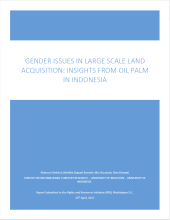Land Library
Bem-vindo à Biblioteca do Land Portal. Explore nossa vasta coleção de recursos de acesso aberto (mais de 74.000), incluindo relatórios, artigos de revistas científicas, trabalhos de pesquisa, publicações revisadas por pares, documentos jurídicos, vídeos e muito mais.
/ library resources
Showing items 19 through 27 of 256.This Environmental Annual report 2016-17 is prepared by The Ministry of Environment, Forest and Climate Change (MoEFCC), Government of India.
The Independent People’s Tribunal (IPT) undertook an inquiry on the status of implementation of FRA to understand and analyze the reasons behind the lack of implementation and/or the violations in the implementation of the Act. The objectives of IPT were to:
The oil palm boom in Indonesia continues to be a major driver of land acquisitions in remaining tropical forest frontiers, drawing on a wide range of actors into its production, and transforming both rural landscapes and livelihoods in the process.
The study tried to assess the state of data in India, particularly to track and report two critical land governance indicators viz. women land rights and forest rights, critical to ensure equity and sustainability in terms of public policy.
This paper was presented at the “2017 WORLD BANK CONFERENCE ON LAND AND POVERTY”, The World Bank - Washington DC. This paper provides a comparative appreciation of all the datasets especially the metadata and methodology along with a SWOT vis-à-vis reporting requirement of SDG indicator.
This Backgrounder is the first in a multi-authored series on Cultivating Gender Justice.
Ministry of Tribal Affairs, Government of India is the nodal ministry authorized for the implementation of the Scheduled Tribes and Other Traditional Forest Dwellers (recognition of Forest rights) Act, 2006.
This report produced by Centre for Policy Research (CPR) a comprehensive and systematic study of Supreme Court cases on land acquisition from 1950- 2016 and examined particular conflicts involving major dams, special economic zones, housing complexes and industrial projects.
Poor rural women in developing countries are critical to the survival of their families. Fertile land is their lifeline. But the number of people negatively affected by land degradation is growing rapidly.

